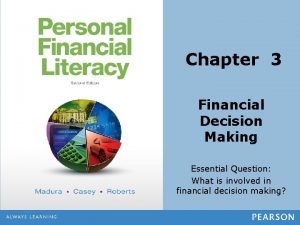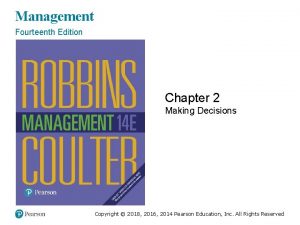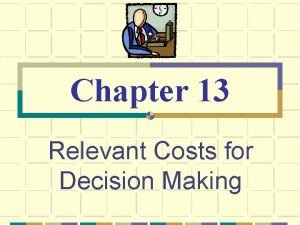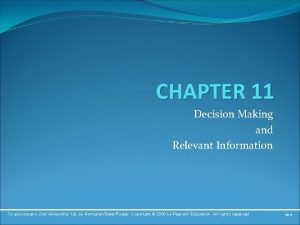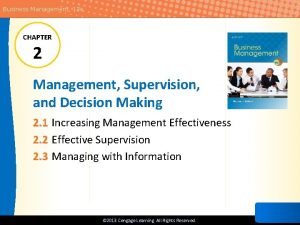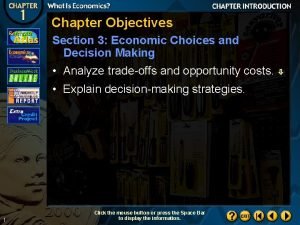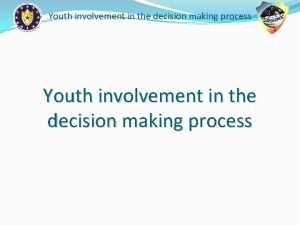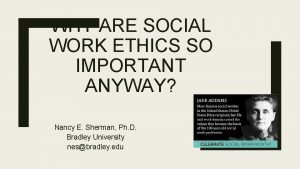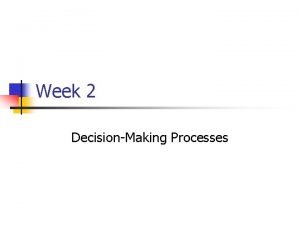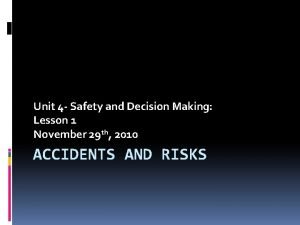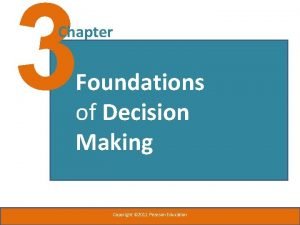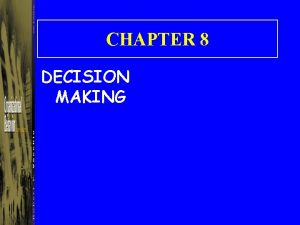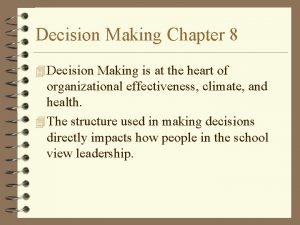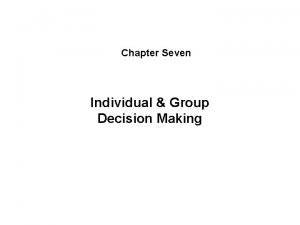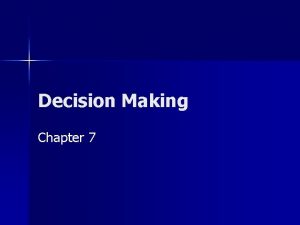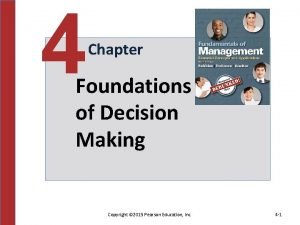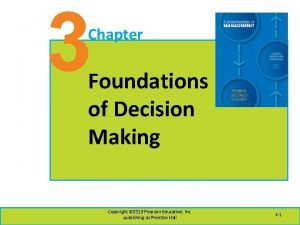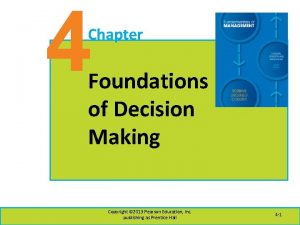3 Chapter Foundations of Decision Making Copyright 2011

























- Slides: 25

3 Chapter Foundations of Decision Making Copyright © 2011 Pearson Education, Inc. publishing as Prentice Hall

Learning Outcomes • Describe the decision-making process • Explain the three approaches managers can use to make decisions • Describe the types of decisions and decisionmaking conditions managers face • Discuss group decision making • Discuss contemporary issues in managerial decision making Copyright © 2011 Pearson Education, Inc. publishing as Prentice Hall 3 -2

How Do Managers Make Decisions? • Decision-Making Process • A set of eight steps that includes identifying a problem, selecting a solution, and evaluating the effectiveness of the solution • Problem • A discrepancy between an existing and a desired state of affairs • Decision Criteria • Factors that are relevant in a decision Copyright © 2011 Pearson Education, Inc. publishing as Prentice Hall 3 -3

Copyright © 2011 Pearson Education, Inc. publishing as Prentice Hall 3 -4

Copyright © 2011 Pearson Education, Inc. publishing as Prentice Hall 3 -5

Copyright © 2011 Pearson Education, Inc. publishing as Prentice Hall 3 -6

Copyright © 2011 Pearson Education, Inc. publishing as Prentice Hall 3 -7

Decision Implementation • Putting a decision into action; includes conveying the decision to the persons who will be affected by it and getting their commitment to it. Copyright © 2011 Pearson Education, Inc. publishing as Prentice Hall 3 -8

Common Errors in the Decision. Making Process • Heuristics – “rules of thumb” to simplify decision making – May lead to errors and biases • Overconfidence Bias – Unrealistically positive views of one’s self Copyright © 2011 Pearson Education, Inc. publishing as Prentice Hall 3 -9

Copyright © 2011 Pearson Education, Inc. publishing as Prentice Hall 3 -10

What is the Rational Model of Decision Making? • Rational Model assumes – that managers’ decision making will be rational logical and consistent choices to maximize value – The problem faced would be clear and unambiguous – the decision maker would have a clear and specific goal – know all possible alternatives and consequences Copyright © 2011 Pearson Education, Inc. publishing as Prentice Hall 3 -11

What is Bounded Rationality? • Managers are limited in their ability to process information • Because managers can’t analyze information on all alternatives, they satisfice Copyright © 2011 Pearson Education, Inc. publishing as Prentice Hall 3 -12

Copyright © 2011 Pearson Education, Inc. publishing as Prentice Hall 3 -13

What Role Does Intuition Play in Managerial Decision Making? • Intuitive Decision Making – making decisions on the basis of experience, feelings and accumulated judgment – described as “unconscious reasoning. ” Copyright © 2011 Pearson Education, Inc. publishing as Prentice Hall 3 -14

Copyright © 2011 Pearson Education, Inc. publishing as Prentice Hall 3 -15

How Do Problems Differ? • Structured Problem – A straightforward, familiar, and easily defined problem • Unstructured Problem – A problem that is new or unusual for which information is ambiguous or incomplete. Copyright © 2011 Pearson Education, Inc. publishing as Prentice Hall 3 -16

What Are Programmed and Nonprogrammed Decisions? • Programmed Decisions – A repetitive decision that can be handled using a routine approach • Nonprogrammed Decisions – A unique and nonrecurring decision that requires a custom-made solution. Copyright © 2011 Pearson Education, Inc. publishing as Prentice Hall 3 -17

Programmed Decision-Making Aids • Policy – A general guide that establishes parameters for making decisions about recurring problems. • Procedure – A series of interrelated sequential steps that can be used to respond to a well-structured problem (policy implementation). • Rule – An explicit statement that tells managers what they ought or ought not to do (limits on procedural actions). Copyright © 2011 Pearson Education, Inc. publishing as Prentice Hall 3 -18

Copyright © 2011 Pearson Education, Inc. publishing as Prentice Hall 3 -19

What Decision Making Conditions Do Managers Face? • Certainty – A situation in which a decision maker can make accurate decisions because all outcomes are known • Uncertainty – A situation in which a decision maker has neither certainty nor reasonable probability estimates available • Risk – A situation in which a decision maker is able to estimate the likelihood of certain outcomes Copyright © 2011 Pearson Education, Inc. publishing as Prentice Hall 3 -20

Group Decision Making • Advantages • Disadvantages – Group decisions provide more complete information – Diversity of experiences and perspectives are higher – Groups generate more alternatives – Group decisions increase acceptance of a solution – Group decisions are time consuming – May be subject to minority domination – Subject to pressure to conform – Responsibility is ambiguous – Subject to Groupthink which undermines critical thinking Copyright © 2011 Pearson Education, Inc. publishing as Prentice Hall 3 -21

When Are Groups Most Effective? • Groups are more effective for decisions requiring – – Accuracy Speed Creativity Acceptance • Ideal Group Size – 5 -15 Copyright © 2011 Pearson Education, Inc. publishing as Prentice Hall 3 -22

How Can You Improve Group Decision Making? • Brainstorming – An idea-generating process that encourages alternatives while withholding criticism • Nominal Group Technique – A decision-making technique in which group members are physically present but operate independently • Electronic Meeting – Participants are linked by computer Copyright © 2011 Pearson Education, Inc. publishing as Prentice Hall 3 -23

What Contemporary Decision-Making Issues Do Managers Face? • Ringisei – Japanese consensusforming group decisions. • Creativity – The ability to produce novel and useful ideas Copyright © 2011 Pearson Education, Inc. publishing as Prentice Hall 3 -24

Copyright © 2011 Pearson Education, Inc. publishing as Prentice Hall 3 -25
 No decision snap decision responsible decision
No decision snap decision responsible decision Investment decision financing decision dividend decision
Investment decision financing decision dividend decision Chapter 6 prices and decision making assessment answers
Chapter 6 prices and decision making assessment answers Chapter 11 decision making and relevant information
Chapter 11 decision making and relevant information Chapter 2 economic systems and decision making
Chapter 2 economic systems and decision making Management chapter 5 planning and decision making
Management chapter 5 planning and decision making Chapter 3 financial decision making
Chapter 3 financial decision making Chapter 2 economic systems and decision making
Chapter 2 economic systems and decision making Chapter 2 decision making
Chapter 2 decision making Relevant cost for decision making solution chapter 13
Relevant cost for decision making solution chapter 13 Chapter 2 economic systems and decision making answer key
Chapter 2 economic systems and decision making answer key Chapter 11 decision making and relevant information
Chapter 11 decision making and relevant information Chapter 2 management supervision and decision making
Chapter 2 management supervision and decision making Chapter 11 decision making and relevant information
Chapter 11 decision making and relevant information Management chapter 5 planning and decision making
Management chapter 5 planning and decision making Chapter 1 section 3 economic choices and decision making
Chapter 1 section 3 economic choices and decision making Decision tree and decision table
Decision tree and decision table Youth involvement
Youth involvement Nasw code of ethics
Nasw code of ethics Systematic decision making process
Systematic decision making process What doing our country
What doing our country Using recursion in models and decision making
Using recursion in models and decision making Using functions in models and decision making
Using functions in models and decision making Paced decision making
Paced decision making Unit 4 lesson 1 decision making
Unit 4 lesson 1 decision making How to improve marketing performance
How to improve marketing performance






